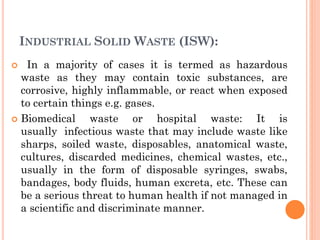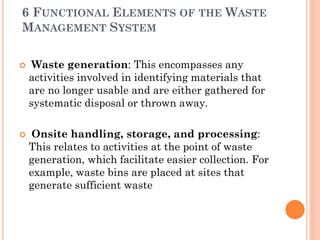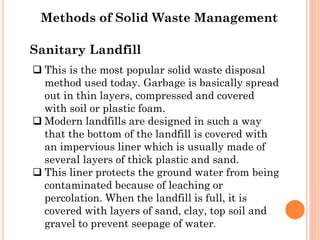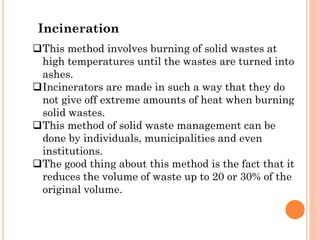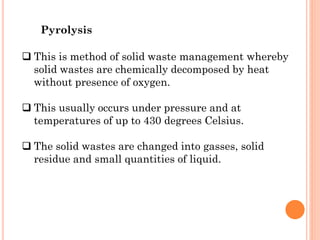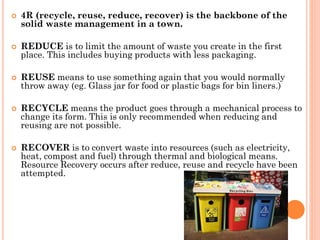Solid waste management
- 1. SOLID WASTE MANAGEMENT PRASANNA R KOVATH ASSISTANT PROFESSOR DEPARTMENT OF BIOTECHNOLOGY ST.MARY’S COLLEGE THRISSUR
- 2. What is Solid Waste? • Solid waste is the unwanted or useless solid materials generated from human activities in residential, industrial or commercial areas. • Solid waste means any garbage, refuse, sludge from a wastewater treatment plant, water supply treatment plant, or air pollution control facility and other discarded materials including solid, liquid, semi-solid, or contained gaseous material, resulting from industrial, commercial, mining and agricultural operations, and from community activities • In Simple Words - Solid wastes are any discarded or abandoned materials. Solid wastes can be solid, liquid, semi-solid or containerized gaseous material.
- 3. Types of Solid Waste It can be classified into different types depending on their source: •Municipal Solid Waste (MSW): It consists of household waste, construction and demolition debris (CnD), sanitation residue, and waste from streets, generated mainly from residential and commercial complexes. As per the MoEF it includes commercial and residential waste generated in municipal or notified areas in either solid or semi-solid form excluding industrial hazardous wastes but including treated bio-medical wastes
- 4. INDUSTRIAL SOLID WASTE (ISW): In a majority of cases it is termed as hazardous waste as they may contain toxic substances, are corrosive, highly inflammable, or react when exposed to certain things e.g. gases. Biomedical waste or hospital waste: It is usually infectious waste that may include waste like sharps, soiled waste, disposables, anatomical waste, cultures, discarded medicines, chemical wastes, etc., usually in the form of disposable syringes, swabs, bandages, body fluids, human excreta, etc. These can be a serious threat to human health if not managed in a scientific and discriminate manner.
- 5. OBJECTIVES OF WASTE MANAGEMENT The primary goal of solid waste management is reducing and eliminating adverse impacts of waste materials on human health and the environment It also aims to support economic development and superior quality of life. This is to be done in the most efficient manner possible, to keep costs low and prevent waste buildup.
- 6. SOLID WASTE MANAGEMENT 1.Centralised method: This method involves collection of municipal waste from all over the local area and by means of landfilling, dump outside the city/nagar panchayat limits. This process looks at door-to-door collection of solid waste by waste pickers who hand over to the collection team who then discard the collected waste in the landfill. The waste pickers are employees of the Municipal Corporation or Nagar Panchayat. The collection team is generally contracted out by a tendering process.
- 7. DE-CENTRALIZED METHOD This is a model seen in a few places like Suryapet in Andhra Pradesh and Bangalore in Karnataka. The waste is collected ward-wise and is segregated at source into bio-degradable and non biodegradable. The biodegradable waste is composted at a nearby facility by different methods of aerobic and anerobic composting. The non-biodegradable waste is further categorised into paper, plastic, metal and other waste and then further collected by recyclers for up-cycling or downcycling of products
- 8. 6 FUNCTIONAL ELEMENTS OF THE WASTE MANAGEMENT SYSTEM Waste generation: This encompasses any activities involved in identifying materials that are no longer usable and are either gathered for systematic disposal or thrown away. Onsite handling, storage, and processing: This relates to activities at the point of waste generation, which facilitate easier collection. For example, waste bins are placed at sites that generate sufficient waste
- 9. WASTE COLLECTION Waste collection: A crucial phase of waste management, This includes activities such as placing waste collection bins, collecting waste from those bins, and accumulating trash in the location where the collection vehicles are emptied. Although the collection phase involves transportation, this is typically not the main stage of waste transportation.
- 10. Waste processing and recovery: This refers to the facilities, equipment, and techniques employed to recover reusable or recyclable materials from the waste stream and to improve the effectiveness of other functional elements of waste management Disposal: The final stage of waste management. It involves the activities aimed at the systematic disposal of waste materials in locations such as landfills or waste-to- energy facilities.
- 11. . Methods of Solid Waste Management Sanitary Landfill This is the most popular solid waste disposal method used today. Garbage is basically spread out in thin layers, compressed and covered with soil or plastic foam. Modern landfills are designed in such a way that the bottom of the landfill is covered with an impervious liner which is usually made of several layers of thick plastic and sand. This liner protects the ground water from being contaminated because of leaching or percolation. When the landfill is full, it is covered with layers of sand, clay, top soil and gravel to prevent seepage of water.
- 12. Incineration This method involves burning of solid wastes at high temperatures until the wastes are turned into ashes. Incinerators are made in such a way that they do not give off extreme amounts of heat when burning solid wastes. This method of solid waste management can be done by individuals, municipalities and even institutions. The good thing about this method is the fact that it reduces the volume of waste up to 20 or 30% of the original volume.
- 13. Recovery and Recycling Recycling or recovery of resources is the process of taking useful but discarded items for next use. Traditionally, these items are processed and cleaned before they are recycled. The process aims at reducing energy loss, consumption of new material and reduction of landfills..
- 14. Composting Due to lack of adequate space for landfills, biodegradable yard waste is allowed to decompose in a medium designed for the purpose. Only biodegradable waste materials are used in composting. Good quality environmentally friendly manure is formed from the compost and can be used for agricultural purposes.
- 15. Pyrolysis This is method of solid waste management whereby solid wastes are chemically decomposed by heat without presence of oxygen. This usually occurs under pressure and at temperatures of up to 430 degrees Celsius. The solid wastes are changed into gasses, solid residue and small quantities of liquid.
- 16. waste management hierarchy • The waste management hierarchy indicates an order of preference for action to reduce and manage waste, and is usually presented diagrammatically in the form of a pyramid. • The hierarchy captures the progression of a material or product through successive stages of waste management and represents the latter part of the life-cycle for each product.
- 17. waste management hierarchy The aim of the waste hierarchy is to extract the maximum practical benefits from products and to generate the minimum amount of waste. The proper application of the waste hierarchy can have several benefits. It can help prevent emissions of greenhouse gases, reduces pollutants, save energy, conserves resources, create jobs and stimulate the development of green technologies.
- 18. 4R (recycle, reuse, reduce, recover) is the backbone of the solid waste management in a town. REDUCE is to limit the amount of waste you create in the first place. This includes buying products with less packaging. REUSE means to use something again that you would normally throw away (eg. Glass jar for food or plastic bags for bin liners.) RECYCLE means the product goes through a mechanical process to change its form. This is only recommended when reducing and reusing are not possible. RECOVER is to convert waste into resources (such as electricity, heat, compost and fuel) through thermal and biological means. Resource Recovery occurs after reduce, reuse and recycle have been attempted.
- 19. Integrated solid waste management Integrated solid waste management refers to the strategic approach to sustainable management of solid wastes covering all sources and all aspects, covering generation, segregation, transfer, sorting, treatment, recovery and disposal in an integrated manner, with an emphasis on maximizing resource use efficiency.
- 20. Integrated solid waste management Benefits of ISWM Cleaner and safe neighborhoods Higher resource use efficiency Resource augmentation Savings in waste management costs due to reduced levels of final waste for disposal Better business opportunities and economic growth Local ownership & responsibilities / participation
- 21. The most important reason for waste collection is the protection of the environment and the health of the population. The Earth is what we all have in common…. CONSERVE FOR FUTURE



